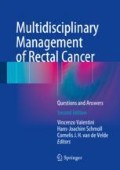Abstract
After curative resection of rectal cancer, nowadays around 3% of patients develop a local relapse. The main challenge is to detect these local recurrences when they are still curable. There is no strong evidence at which frequency follow-up visits should be done and with which tools. According to current guidelines, routine surveillance in patients with colorectal cancer should at least include regular clinical examination and CEA testing. Most international guidelines also advice annual CT of the chest and abdomen (including the pelvis in patients with rectal cancer). Particularly in patients with an increased risk for local recurrence (based on prognostic factors, elevated CEA levels or clinical symptoms), routine imaging is justified. In case of equivocal CT findings, PET is more beneficial in identifying a local relapse. Currently the main role of MRI is to establish the resectability of a local tumour recurrence once it has been diagnosed. A new dilemma in rectal tumours is the follow-up of patients undergoing organ-preserving treatments. In these patients one may assume that a more intensive follow-up is justified to detect any potential tumour regrowth as early as possible in order to offer patients salvage surgery without compromising the oncological outcome. However, intensification of the follow-up in this specific group is mainly in study settings, and there is no proof yet whether the patients benefit from an intensified follow-up and – if so – at which frequency.
Abbreviations
- ASCO :
-
American Society of Clinical Oncology
- CEA:
-
Carcinoembryonic Antigen
- CT:
-
Computed Tomography
- DCE:
-
Dynamic Contrast Enhanced
- DWI:
-
Diffusion-Weighted (Magnetic Resonance) Imaging
- ESMO:
-
European Society of Medical Oncology
- FACS (trial):
-
Follow-up After Colorectal Surgery
- GILDA (trial):
-
Gruppo Italiano di Lavoro per la Diagnosi Anticipata
- MRI:
-
Magnetic Resonance Imaging
- NCCN:
-
National Comprehensive Cancer Network
- PET/FDG-PET:
-
Positron Emission Tomography/18F-Fluorodeoxygenase
Positron Emission Tomography
- RCT:
-
Randomised Controlled Trial
- TME:
-
Total Mesorectal Excision
- TNM:
-
Tumour, Node, Metastasis
References
Arriola E, Navarro M, Parés D, Muñoz M, Pareja L, Figueras J, Soler G, Martinez M, Majem M, Germa-Lluch JR (2006) Imaging techniques contribute to increased surgical rescue of relapse in the follow-up of colorectal cancer. Dis Colon Rectum 49:478–484
Baca B, Beart RW Jr, Etzioni DA (2011) Surveillance after colorectal cancer resection: a systematic review. Dis Colon Rectum 54:1036–1048
Desch CE, Benson AB 3rd, Somerfield MR, Flynn PJ, Krause C, Loprinzi CL, Minsky BD, Pfister DG, Virgo KS, Petrelli NJ, American Society of Clinical Oncology (2005) Colorectal cancer surveillance: 2005 update of an American Society of Clinical Oncology practice guideline. J Clin Oncol 23:8512–8519
Figueredo A, Rumble RB, Maroun J, Earle CC, Cummings B, McLeod R, Zuraw L, Zwaal C, Gastrointestinal Cancer Disease Site Group of Cancer Care Ontario’s Program in Evidence-based Care (2003) Follow-up of patients with curatively resected colorectal cancer: a practice guideline. BMC Cancer 3:26
Glimelius B, Pahlman L, Cervantes A, ESMO Guidelines Working Group (2010) Rectal cancer: ESMO clinical practice guidelines for diagnosis, treatment and follow-up. Ann Oncol 21(Suppl 5):v82–v86
Habr-Gama A, Gama-Rodrigues J, São Julião G, Proscurshim I, Sabbagh C, Lynn PB, Perez RO (2014) Local recurrence after complete clinical response and watch and wait in rectal cancer after neoadjuvant chemoradiation: impact of salvage therapy on local disease control. Int J Radiat Oncol Biol Phys 88:822–828
Jeffery GM, Hickey BE, Hider P (2002) Follow-up strategies for patients treated for non-metastatic colorectal cancer. Cochrane Database Syst Rev:CD002200
Kievit J (2002) Follow-up of patients with colorectal cancer: numbers needed to test and treat. Eur J Cancer 38:986–999
Maas M, Rutten IJ, Nelemans PJ, Lambregts DM, Cappendijk VC, Beets GL, Beets-Tan RG (2011) What is the most accurate whole-body imaging modality for assessment of local and distant recurrent disease in colorectal cancer? A meta-analysis: imaging for recurrent colorectal cancer. Eur J Nucl Med Mol Imaging [April 6, Epub ahead of print]
Maas M, Beets-Tan RGH, Lambregts DMJ, Lammering G, Nelemans PJ, Engelen SME, van Dam RM, Jansen RLH, Sosef M, Leijtens JWA, Hulsewé KWE, Buijsen J, Beets GL (2011) Wait-and-see policy for clinical complete responders after chemoradation for rectal cancer. J Clin Oncol 29:4633–4640
Primrose JN, Perera R, Gray A, Rose P, Fuller A, Corkhill A, George S, Mant D; FACS trial investigators (2014) Effect of 3 to 5 years of scheduled CEA and CT follow-up to detect recurrence of colorectal cancer: the FACS randomized clinical trial. JAMA 311:263–270
Renehan AG, Egger M, Saunders MP, O’Dwyer ST (2002) Impact on survival of intensive follow up after curative resection of colorectal cancer: systematic review and meta-analysis of randomised trials. BMJ 324:813
Smith JD, Ruby JA, Goodman KA, Saltz LB, Guillem JG, Weiser MR, Temple LE, Nash GM, Paty PB (2012) Nonoperative management of rectal cancer with complete clinical response after neoadjuvant therapy. Ann Surg 256:965–972
Titu LV, Breen DJ, Nicholson AA, Hartley J, Monson JR (2006) Is routine magnetic resonance imaging justified for the early detection of resectable liver metastases from colorectal cancer? Dis Colon Rectum 49:810–815
Tjandra JJ, Chan MK (2007) Follow-up after curative resection of colorectal cancer: a meta-analysis. Dis Colon Rectum 50:1783–1799
Valentini V, van Stiphout RG, Lammering G, Gambacorta MA, Barba MC, Bebenek M, Bonnetain F, Bosset JF, Bujko K, Cionini L, Gerard JP, Rödel C, Sainato A, Sauer R, Minsky BD, Collette L, Lambin P (2011) Nomograms for predicting local recurrence, distant metastases, and overall survival for patients with locally advanced rectal cancer on the basis of European randomized trials. J Clin Oncol 29(23):3163–3172
Author information
Authors and Affiliations
Corresponding author
Editor information
Editors and Affiliations
Rights and permissions
Copyright information
© 2018 Springer-Verlag Berlin Heidelberg
About this chapter
Cite this chapter
Lambregts, D.M.J., Beets-Tan, R.G.H. (2018). How Can We Identify Local Relapse?. In: Valentini, V., Schmoll, HJ., van de Velde, C. (eds) Multidisciplinary Management of Rectal Cancer. Springer, Cham. https://doi.org/10.1007/978-3-319-43217-5_15
Download citation
DOI: https://doi.org/10.1007/978-3-319-43217-5_15
Published:
Publisher Name: Springer, Cham
Print ISBN: 978-3-319-43215-1
Online ISBN: 978-3-319-43217-5
eBook Packages: MedicineMedicine (R0)

